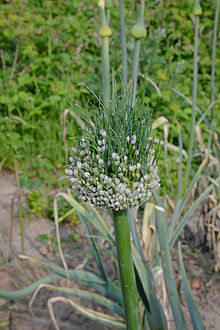Viviparity
Viviparity ( Latin: viviparus , viviparous , viviparous, live- bearing ) or live birth describes the mode of reproduction in animals whose early development ( embryonic and fetal stage ) takes place in the mother without being enclosed by an egg shell . In plants, viviparia describes the embryonic development of the mother plant.
Animals
In animals, viviparity is in contrast to oviparity , i.e. the oviposition, after which the early development in the egg takes place for the most part outside the mother animal. In the case of viviparia, the young remain in the womb throughout their early development.
A clear demarcation of matrotrophen Viviparie (nutrition through the mother, after a period in which the embryos feed upon the yolk) for ovoviviparity ( lecithotrophen yolk fed Viviparie) in the yolk-rich Nähreier in the womb hatched are and the embryos only by the yolk sac of Feeding stored nutrients on ice is difficult. Ovoviviparity is often equated with aplacental viviparity and viviparity with placental viviparity , but this is incorrect: the embryos of viviparous animals are supplied by the mother's circulation (nutrients, respiratory gases , excretion , water ), which does not necessarily require a placenta . The following options for supplying the embryo in the womb are known:
- In all higher mammals (Eutheria) and some marsupial mammals a placenta is formed. But there are also placenta formations in various skinks and some snakes , in which the allantois and chorion of the embryo combine and attach closely to the mother's uterine mucosa . In some lizards , certain layers of tissue that separate the mother and embryo are reduced until there is contact between the endothelia of the embryo and the mother, which is considered to be placenta formation. In most basic sharks , the folded yolk sac that is closely connected to the fallopian tube forms a yolk sac placenta. Placenta formations also occur in some of the dentists .
Occasionally one finds the term for all placental viviparous animals placental mammals , which but a taxonomic group namely, mammals - subclass should remain Eutheria, reserved, even if he is selected as unhappy for this, as just some marsupial form a placenta. In order not to add to the confusion, it should be avoided as a collective term for unrelated groups with the same embryonic care. - One possibility of aplacental supply of the embryo is the excretion of a nutrient secretion into the uterus. This "uterine milk" is mixed with leukocytes and tissue remnants . It can be absorbed directly by the embryos or via secretion villi through the injection hole (in rays ) or the gills in real bony fish (Teleostei) into the intestine of the embryo. The embryo can also develop processes for the purpose of nutrition ( trophotaenia ), as is the case with highland penguins (Goodeidae). Other representatives of the dentist have developed other forms of nutrition, especially those that develop in the ovary.
- Another form of nutrition for the embryo is called "intrauterine cannibalism" or oophagia . Only a few or only one of the eggs develop in the fallopian tube or in the uterus, the others break down into a nutrient paste or are eaten by the remaining embryo or embryos. This form can be found among other things in some perch (Perciformes), in mackerel shark-like (Lamniformes) or also in the Alpine salamander .
Since the young of viviparous species develop in the confined womb during their embryonic development, these species usually have fewer offspring compared to oviparous species and are therefore K-strategists in terms of the reproductive strategy . The oldest fossil evidence of live bears is the 380 to 375 million year old find of an embryo of the Upper Devonian tank fish Materpiscis connected to the mother by an umbilical cord .
plants
In botany , the term viviparity is used to denote forms of reproduction in which the seedling remains on the mother plant, as well as for certain forms of vegetative reproduction when inherited daughter plants arise from the flower systems. Examples of viviparity in the plant kingdom are bluegrass such as Poa vivipara (South Africa) and Poa alpina ssp. vivipara (found in the Alps); it can also be observed in the foxtail grasses and in many plants in the mangrove biotope such as z. B. Rhizophora mangle .
It is divided into real and fake viviparia.
- Real viviparity; the young seed plant (seed plant) already grows out of the seed when it is still connected to the (living) mother plant via the fruit.
- Cryptovivipary; without the seedling leaving the fruit.
- Fake, false viviparial, pseudoviviparous ; Term for vegetative brood bud formation in the inflorescence area and its outgrowth (via mitoses ) to be inherited, young daughter plants
literature
- Erwin Hentschel, Günther Wagner: Zoological dictionary. Animal names, general biological, anatomical, physiological terms and biographical data. 4th revised and expanded edition. Gustav Fischer Verlag, Jena 1990, ISBN 3-334-00348-5 .
- Lothar Kampf , Rolf Kittel, Johannes Klapperstück: Guide to the anatomy of vertebrates. 5th revised edition. Gustav Fischer Verlag, Jena 1987, ISBN 3-334-00082-6 .
- Hans-Günter Petzold : Tasks and problems in researching the expressions of life of the lower amniotes (reptiles). In: Milu. Messages from the Tierpark Berlin-Friedrichsfelde. Vol. 5, Issue 4/5, 1982, ISSN 0076-8839 , pp. 485-786, (reprint: (= Berliner Tierpark-Buch. No. 38). Verlag für Biologie und Natur, Berlin 1984).
- Adolf Remane , Volker Storch , Ulrich Welsch : Short textbook of zoology. 6th revised edition, Gustav Fischer Verlag, Stuttgart et al. 1989, ISBN 3-334-00333-7 .
Individual evidence
- ↑ Wilfried Westheide, Gunde Rieger: Special Zoology. Part 2: Vertebrate or skull animals , 2nd edition, Spectrum, 2010, ISBN 978-3-8274-2039-8 , p. 389.
- ^ Long et al. 2008

